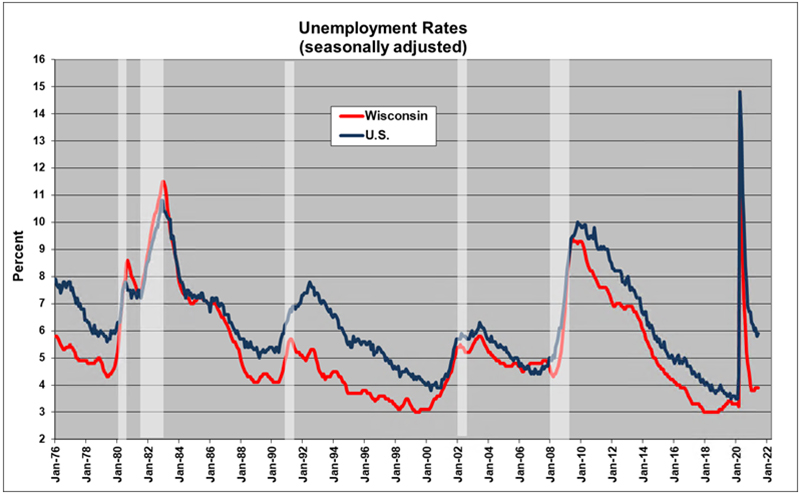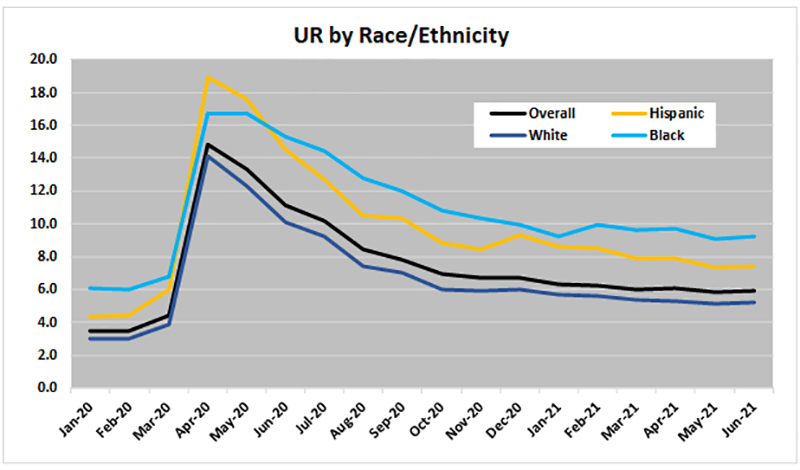Outdated or Unsupported Browser Detected
DWD's website uses the latest technology. This makes our site faster and easier to use across all devices. Unfortunatley, your browser is out of date and is not supported. An update is not required, but it is strongly recommended to improve your browsing experience. To update Internet Explorer to Microsoft Edge visit their website.
Wisconsin jobs set an all-time high on a seasonally adjusted (SA) current employment statistics (CES) basis in February 2020 at 2,997,800. That same month Wisconsin's unemployment rate (UR) was 3.3%.
The workforce ramifications of Covid-19 pandemic registered in April (CES survey done in the week that contains the 12th). Total non-farm Wisconsin jobs were down 407,800 in April from February highs.
As of June 2021, Wisconsin has gained back 281,500 of the lost jobs, putting it down still 126,300 from the February 2020 peak. .
| Level | When | |
|---|---|---|
| Peak Jobs | 2,997,800 | February 2020 |
| Pandemic Job Trough | 2,590,000 | April 2020 |
| Peak Loss | 407,800 | April 2020 |
| Current | 2,871,500 | June 2021 |
| Gain from Peak Loss | 281,500 | June 2021 |
| Down from Peak | 126,300 | June 2021 |
The unemployment rate also saw large changes over the period. The UR increased to 14.8% in April 2020, which was higher than the Great Recession peak UR of 9.4% in June 2009 and even higher than the 11.5% registered in December 1982. The current UR is 3.9%.
| Level | When | |
|---|---|---|
| Low UR | 3.2% | March 2020 |
| High UR | 14.8% | April 2020 |
| Current UR | 3.9% | June 2021 |
| Previous Peak UR | 11.5% | January 1983 |
| Great Recession Peak UR | 9.4% | June 2009 |
| Lowest UR | 3.0% | Dec 17 - Nov 18 |
There are 711,930 Wisconsin workers who earn less than $14.22 per hour, totaling 26.3% of Wisconsin workers (2,709,940 as of Occupational Employment and Wage Statistics (OEWS) May estimates). There are 300,716 state workers that earn between $14.22 and $16.76 per hour. The sum of these two categories is 1,012,646, meaning 37.4% of Wisconsin workers earn less than $16.75 per hour, the annual equivalent of $34,840.
The plurality of Wisconsin workers that earn less than $14.22 per hour are in the Food Preparation and Serving occupations, some 156,345. More than 78% of Food Preparation and Serving workers earn less than $14.22 per hour and almost 90% earn $16.75 per hour or less. Sales and related occupations number second with 110,695 workers, or 45.1% earning less than $14.22.
Other low-wage workers are concentrated in the Personal Care & Service and Healthcare Support occupations. Personal Care & Service occupations have 59.0% of workers earning less than $14.22 per hour and 72.2% earning $16.75 per hour or less. Approximately 51.2% of the Healthcare Support occupations earn less than $14.22 and 73.7% earn $16.75 or less.
In Building & Ground Maintenance occupations, 51.4% earn less than $14.22 per hour and 69.7% earn $16.75 per hour or less.
In Construction & Extraction occupations, 14.5% earn $16.75 per hour or less, and 36.0% of Production workers earn $16.75 per hour or less.
The employment effects of Covid-19 were rapid and dramatic and were reflected in the unemployment rates. The U.S. seasonally adjusted (SA) unemployment rate rocketed from 3.5% in February 2020, to 4.4% in March, to 14.8% in April 2020.
The Wisconsin rate change was similar but more condensed, rising from 3.2% in March to 14.8% in April. This movement was by far largest and fastest movement in history.

The subsequent decline in the UR was almost as dramatic, dropping to 6.8% for the U.S. by March 2021 and to 3.8% for Wisconsin.
The UR changes by race/ethnicity and gender showed congruent but not identical movements. For example, the UR for whites increased from 3.0% in February 2020 to 14.1% in April, whereas the UR for Blacks rose from 6.0% in February to 16.7% in April. The base differences in initial levels notwithstanding, the relative percentage point gains were not substantially different between the two groups – 11.1 percentage points (ppts) for whites versus 10.7 ppts for Blacks. Hispanic UR, however, rose from 4.4% to 18.9% for the same period, a difference of 14.5 ppts.
The declines in UR for the groups also varied. From the peaks, the UR for whites fell 8.8 ppts to 5.3% by April 2021. The UR for Blacks fell 7.0 ppts. While the UR for Hispanics increased the most, it also fell the most rapidly, 11.0 ppts from April 2020 to April 2021. The drop in the Hispanic rates outpaced all in the months shortly following the peaks, falling below the UR for Blacks by June and remaining at its normal lower level ever since.

The UR changes by gender were again similarly, but not identically, influenced by Covid-19 activity.
Millions of parents, mostly mothers, have stopped working for pay because of the pandemic childcare crisis (Claire Cain Miller, The New York Times, "Shorter Hours, No Promotions: How the Pandemic Stalled Some Parents’ Careers"). But for many more who have held on to their jobs, childcare demands have also affected their careers, often in less visible ways.
Many women have worked fewer hours, declined assignments, or decided not to take a promotion or pursue a new job. Economists call this the intensive margin — how much people work, as opposed to how many are in the labor force — and it’s harder to quantify in official employment statistics.
Yet there is evidence that employed parents have slowed their careers while childcare schedules continue to be upended. It has short-term effects on their professional contributions and could have long-term effects on their careers. Research suggests that it is because American employers tend to penalize people who work at less than full capacity.
WisConomy Data Search Query: jobcenterofwisconsin.com/wisconomy/query
Sub-state data (County, Metro or WDA) is available for the following categories:
Projections Data: jobcenterofwisconsin.com/wisconomy/pub/projections
Hot Jobs Data Dashboard: jobcenterofwisconsin.com/wisconomy/pub/hotjobs
Regional Economists Contact Information: jobcenterofwisconsin.com/wisconomy/pub/contact#wdaContacts